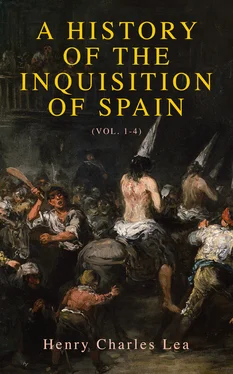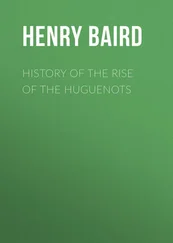[73]Archivo Gen. de Simancas, Inquisicion Libros I, II.
[74]The limitations on the royal jurisdiction are exemplified by the unseemly contest at Alcalá de Henares, in 1485–6, between Isabella and the Archbishop González de Mendoza, respecting her right to administer justice within his province. It lasted from December till the time for opening the campaign against Granada, when she removed to Córdova without having established her claim.—Francisco de Medina, Vida del Cardenal Mendoza (Mem. hist, español, VI, 264).
Yet her jurisdiction was one of the points on which Isabella wisely insisted with the utmost firmness. To quote Cardinal Ximenes again—“Ante todo la dicha Reyna cuidaba de defender su jurisdiccion Real, viendo que por ella los Reyes en Castilla se hacen mas poderosos y mas temidos de sus vasallos” (Valladares, Semanario Erúdito, XX, 238). When, in 1491, the royal court at Valladolid, presided over by Alonzo de Valdevielfo, Bishop of Leon, wrongfully allowed an appeal to Rome, she promptly dismissed the bishop and all the judges and replaced them with Juan Arias del Villar, Bishop of Oviedo, and other assessors.—Crónicon de Valladolid (Coleccion de Documentos para la Historia de España, XIII, 184–5).—Galindez de Carbajal (Ibid. XVIII, 278).
[75]Memorial histórico español, T. II, pp. 68, 72, 86, 94, 102.
[76]Benavides, Memorias de Fernando IV, Coleccion Diplomática, T. II, pp. 3, 7, 46, 75, 81, 178 (Madrid, 1860).—Vicente Santamaria de Paredes, Curso de Derecho Político, p. 509 (Madrid, 1883).—Córtes de los antiguos Reinos de Leon y Castilla, I, 247, 300 (Madrid, 1861).
[77]Benavides, op. cit. II, 363.
[78]Ferreiro, Fucros Municipales de Santiago, III, 44.
[79]Coleccion de Privilegios, T. VI, p. 327 (Madrid, 1833).
[80]Crónica de Don Juan II, año XXXVII, cap. i.
[81]Córtes de Leon y de Castilla, III, 795.
[82]Castillo, Crónica de Don Enrique IV, cap. lxxxvii, xc.—Barrantes, Ilustraciones etc. Lib. VII, cap. xxviii.—Garibay, Compendio Historial, Lib. XVII, cap. xxxi.—Coleccion de Cédulas, III, 103 (Madrid, 1829).—Bienvenido, Oliver y Esteller (Boletin, XIV, 382).
[83]Pulgar, Crónica, P. II, cap. li.—L. Marinæi Siculi de Reb. Hisp. Lib. XIX.—Æl. Anton. Nebriss. Decad. I, Lib. VI, cap. 1–3.—Garibay, Comp. Historial, Lib. XVIII, cap. viii.
[84]Zuñiga, Añales de Sevilla, ann. 1477, No. 1.
[85]Zurita, Hist, del Rey Hernando, Lib. VIII, cap. V.—Galindez de Carvajal (Coleccion de Documentos para la Historia de España, XVIII, 319).
[86]Barrantes, Ilustraciones etc. Lib. VIII, cap. xx.
[87]Coleccion de Cédulas, I, 70, 124, 143, 183; III, 103.
[88]Pulgar, Crónica, P. III, cap. xcv.—Palafox, Obras, VII, 338 (Madrid, 1762).—Fueros de Aragon, fol. 13 (Saragossa, 1624).
[89]Coleccion de Cédulas, IV, 89.
[90]Pulgar, Crónica, P. III, cap. xii.
[91]Novís. Recop. Tit. xxv, Lib. XII.—Barrantes, Ilustraciones etc. Lib. VIII, cap xiii.—Coleccion de Cédulas, IV, 295.—See also the description of the perfected system which excited the admiration of the Venetian ambassador, Paolo Tiepolo, in 1563 (Relazioni, Serie I, T. V, p. 21).
[92]Clemencin, p. 139.
[93]Coleccion de Cédulas, IV, 136, 164, 173, 185, 336, 338; V, 669; VI, 425.—Novís Recop. Tit. xxxv, Lib. XII, ley 18.
[94]Córtes de los antiguos Reinos, IV, 356 (Madrid, 1882)—“E las leyes e costunbres son sujetas alos Reys, que las pueden hazer e quitar a su voluntad, e vuestra Alteza es ley viba e animada en las tierras.”
[95]Coleccion de Cédulas, IV, 333.
[96]Mariana, Lib. XXVIII, cap. xi; Tom. IX, Append. p. xix.—Giustiniani, Historie degl’Ordini Militari, pp. 386, 425, 460 (Venezia, 1692).
[97]Cartas de Ximenes de Cisneros, pp. 120, 131, 181 (Madrid, 1867).—Wadding, Annales Minorum, ann. 1516, n. 12.—Gachard, Correspondence entre Charles-Quint et Adrien VI, p. cxi (Bruxelles, 1859).
[98]Thus Father Gams attributes the Spanish Inquisition to the national peculiarity of the Spaniard, who requires that the State should represent God on earth, and that Christianity should control all public life; he demands unity of faith and not freedom of faith. The Inquisition is an institution for which the Church has no responsibility.—P. Pius Gams, O. S. B., Die Kirchengeschichte von Spanien, III, II, 7, 8, 11, 12.
[99]Septimi Decretal. Lib. V, Tit. i, cap. 5.
[100]Paramo de Orig. Offic. S. Inquisitionis, p. 164.
[101]Fortalicium Fidei, fol. 147 b(Ed. 1494).
[102]Canon. Apostol. n. 69, 70.
[103]Concil. Eliberitan. cap. 16, 49, 50, 78.
[104]S. August, de Adult. Conjug. Lib. I, cap. xviii.
[105]S. Ambros. Epist. XL, n. 26.
[106]S. Joh. Chrysost. adv. Judæos Orat. I, n. 3, 4, 6. Chrysostom’s indignation was especially aroused by the popular belief among Christians in the peculiar sanctity of the synagogues, which rendered oaths taken in them more binding than in a church.
[107]Socrat. H. E. VII, xiii.
[108]Lib. XVI, Cod. Theodos. Tit. viii, Ll. 6, 9, 12, 21, 22, 25, 26, 27; Tit. ix, Ll. 2, 3, 4, 5.
[109]Novell. Theodos. II, Tit. iii.
[110]Edict. Theoderici, cap. 143.—Cassiodori Variar. IV, 33, 43; v, 37. Cf. III, 45.
[111]Concil. Agathens. ann. 506, cap. 40. This was embodied in the canon law (Gratian. Decr. Caus. XXVIII, Q. i, cap. 14). The apologetic tone in which Sidonius Apollinaris, Bishop of Clermont, speaks of Jews whom he likes and who “solent hujusmodi homines honestas habere causas” shows that the more enlightened churchmen felt that any favor shown to the proscribed race exposed them to animadversion (Epistt. Lib. III, Ep. 4; Lib. IV, Ep. 5).
[112]Concil. Quinisext. cap. 11 (Decr. Caus. XXVIII, Q. i, cap. 13).
Конец ознакомительного фрагмента.
Текст предоставлен ООО «ЛитРес».
Прочитайте эту книгу целиком, купив полную легальную версию на ЛитРес.
Безопасно оплатить книгу можно банковской картой Visa, MasterCard, Maestro, со счета мобильного телефона, с платежного терминала, в салоне МТС или Связной, через PayPal, WebMoney, Яндекс.Деньги, QIWI Кошелек, бонусными картами или другим удобным Вам способом.












